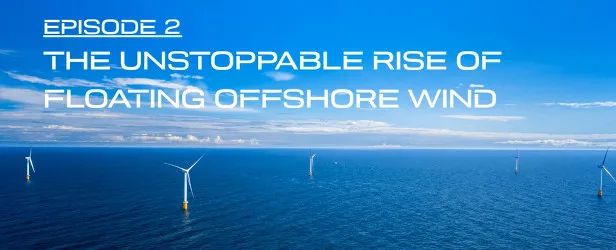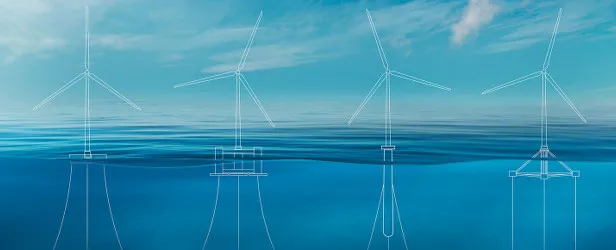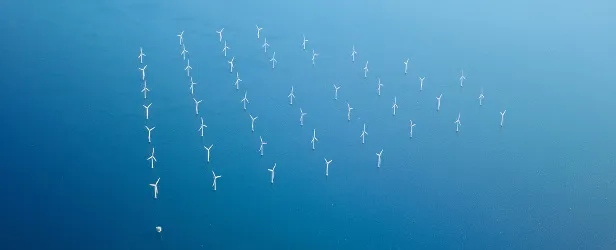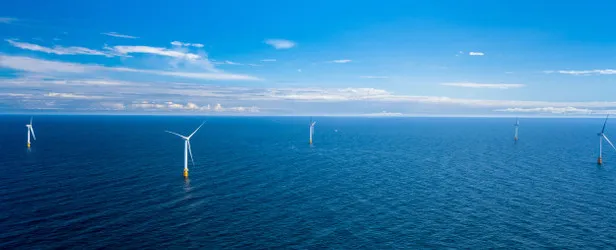|
Transcript:
|
Transcript:
NARRATOR Hello, and welcome to this special episode of DNV’s Talks Energy podcast. With the Paris Agreement strengthening the global response to climate change, countries around the world are facing increasing pressure to phase out carbon-intensive fuels in favour of clean energy. In this two-part documentary we explore the emerging and exciting world of floating offshore wind power, the markets paving the way, and the challenges we must overcome if we’re going to commercialize this growing technology in time to meet targets for global warming reduction. We speak to a range of guests, from organizations across many sectors that are leading the way in development of floating wind, to help us answer the question. What is the potential for this fast-growing renewable energy technology? We hope you enjoy the episode. In episode one of this documentary we examined the global potential for floating wind technology as part of the energy transition. We heard from some of the industry’s key players that its future is bright, but that several challenges remain to be tackled if its potential is to be reached. In this second and concluding episode we look at two of the fundamental factors that will contribute to driving floating wind forwards. We’ll discuss the need for policy makers to create the conditions for floating wind’s success and provide full visibility on their ambitions. But first, we look at the crucial role of technological development in turning the floating wind vision into a reality. |
Transcript:
LUCY CRAIG For floating offshore wind the design challenges, in terms of the interaction between the wind, the waves, and the reaction of the combined structure of the wind turbine and the floater, mean that the engineering challenges are much greater. |
Transcript:
NARRATOR That’s DNV's Vice President for Technology and Innovation, Lucy Craig, who we heard from in the first episode. Lucy told us about the crucial role of technology in floating wind design. |
Transcript:
LUCY CRAIG The floating support structure’s motions have to be taken account, along with the wave loads, currents, wind flows, and the different states of the wind turbine. So, analysing all these potential design factors and combining these variables means that more computing power is needed. We see the need to have more integrated advanced modelling tools which combine those two effects, and also, for example, expanding the use of cloud computing. And also, in operations, digital technology will play an important part in ensuring that these machines can also contribute, for example, to network stability. |
Transcript:
NARRATOR It’s clear, then, that although fixed offshore wind technology provides a framework for development, floating wind poses new technical challenges for the industry to address. And while turbine technology is fundamental to overall design, as we learned in episode one, it’s the foundations, or floaters, where the majority of R&D efforts are currently focused. More from Lucy Craig. |
Transcript:
LUCY CRAIG There are actually four basic technologies which are being explored at a commercial or pre-commercial stage. There are three types, which are floaters, so one is the spar, which is the type that is used by Hywind, one is the semi-submersible, which is the type that’s being used by WindFloat Atlantic. And then there’s the barge type in Japan. There’s another type, which is a tension-leg platform, that is also going through early testing stages. We are aware, as DNV, of around 40 different floaters that are available or coming onto the market, and so we do expect that the coming years will be critical in determining which of these many different types of floater will become the winning technology. |
Transcript:
NARRATOR So what do the manufacturers and integrators leading the way in floating offshore wind make of the technical challenges for foundations? In episode one we heard from Jesper Møller, Head of Offshore Concepts and Solutions at one of the leading suppliers of wind power technologies, Siemens Gamesa. Here, he tells us more about foundation development. |
Transcript:
JESPER MØLLER With regard to whether there is one size that fits all on the foundation side for floating wind turbines, I'm not so sure. And I think there will be room for more than one type of foundations. And I think that there will be room for both steel and concrete. Initially I think that mass production is a bit easier, at least seen from our perspective, to see how we can do that on steel structures. There’s also a lot of interesting developments going on in the industrialization on the concrete side, we just don't know that much about it compared to what we know about steel structures. |
Transcript:
NARRATOR For Jesper and Siemens Gamesa, the ideal foundation designs will be those which are most suited to mass production. |
Transcript:
JESPER MØLLER The way we mass produce that, we think we need to transfer some of that knowledge to foundation production, and change foundations into something that is produced at a shipyard to something that can be produced in factories, where you can accept that parts of the foundations are transported, maybe over longer distances, and final assembly is done in a port, where the assembly can be done at a completely different pace than in a shipyard. And if you look at jacket manufacturing set ups. |
Transcript:
NARRATOR A jacket is a type of fixed offshore wind foundation. |
Transcript:
JESPER MØLLER Good ones, they can produce roughly 50 units per year, but if the floater market kicks off like we hope and think it will, then 50 units per year is nothing from one facility. So, we have developed solutions where we can see that in the end, because if it is done right, we can produce maybe 150 a year. |
Transcript:
NARRATOR Innovative pilot projects are seeking to explore different floating foundation concepts, taking into account both performance and production considerations. One of these is called TetraSpar, which is invested in by a group of partners, including EOLFI, owned by Shell, who we heard from in episode one. Stephane Cicolella, Business Integration Manager and Commercial Director at Shell tells us more. |
Transcript:
STEPHANE CICOLELLA Shell is also a shareholder in the TetraSpar demonstration project. We are together with Stiesdal Offshore Technologies and RWE. We will build and test a new type of floating wind foundation that will shortly be trialled off the coast of Norway. What’s interesting with the TetraSpar technology is that it’s actually a reverse to what we are seeing usually. Usually you go into a site, and you think, okay, what do I need as a fronting foundation to be really efficient from a technical angle on site. TetraSpar is starting from the opposite. Just thinking of how you’re going to build what you need offshore, rather than trying to figure out, once you’ve proven the technology can work as a prototype offshore, how you’re going to build it. And I think it’s critical to have that sort of thinking so that you can be as cost efficient as possible eventually. |
Transcript:
NARRATOR And for Stephane, efficiency and cost reduction are an essential part of technology development. |
Transcript:
STEPHANE CICOLELLA There are many factors that will bring the cost of floating down. Some of these factors will be similar to what happens with bottom fix in the past decade, such as long term targets, a stable and steady partner of projects, volumes, size of the turbines which will drive higher bankability and lower financing costs, etc. But of course, floating has its own specific challenges, so I think that innovative will be another key success factor, and a few breakthroughs will be required. |
Transcript:
NARRATOR While continued innovation will be essential when it comes to areas such as floating foundations and grid integration, more on that shortly, one proven technology area is the turbines themselves. We heard more from Jesper at Siemens Gamesa about turbine development. |
Transcript:
JESPER MØLLER We are striving to make sure that we don’t have to invent something completely new for a floating turbine, because the market is simply too small to support a bespoke floater turbine for now. What will happen in ten years’ time we of course don't know, but for now the market is simply not large enough to support other than using standard turbines to the largest extent possible. Okay, there have to be minor changes made to the controller, and different control algorithms to support different foundation types, so it’s not one type fits all, but basically the main structure of the turbine, and all of the mechanics in the turbine, all of the equipment in the tow line, in the nacelle, all of that needs to be the same as for a bottom fixed turbine. |
Transcript:
NARRATOR So, then, there is a clear way forward in terms of the floater or foundation technology and the turbine. And Hywind Scotland, as we heard in episode one, has proven the performance and commercial viability of a floating wind set up. But what about the role of wider infrastructure in distributing the power generated by floating wind, and how might the electricity be used? |
Transcript:
JESPER MØLLER I think floating foundations and floating wind energy as a whole has an opportunity to create a completely new market, and one of the visions can be that floating wind, you could put that anywhere where you have a decent wind. It doesn’t have to be close to populated areas, which is the key to success on bottom fixed foundations, that you will have to be close to where you have the populated centres, where you can get rid of your power. But for floating wind there could be some opportunities in the far future where we see massive production facilities where we produce electricity with turbines, and we produce hydrogen from that electricity, and that hydrogen is then transformed into various types of free fuels. Floating has this opportunity that you could place it anywhere and don't have to depend on electrical input onshore. |
Transcript:
NARRATOR We’ve explored the role of technology and innovation in advancing floating wind, but there remains one important piece of the puzzle. The role of policy and government action. Lucy Craig outlines the importance of regulatory input in accelerating floating wind’s development and uptake. |
Transcript:
LUCY CRAIG One of the challenges with a new technology is that what will be required perhaps in ten years’ time, and our knowledge of the market in ten years’ time, will be very different from our knowledge now. And so, it’s very important that regulators take into account what future needs might be as well as the current needs. So, permitting should be flexible enough to allow changes as the industry gains experience, and ensure that innovation and evolution is something that projects can continue working with. |
Transcript:
NARRATOR The importance of regulatory intervention, including policy development, becomes tangible when we see just how much developers rely on the actions of government. In episode one we spoke to energy company Equinor, who, as we learned, were the major integrator for the world’s first commercial floating wind farm, Hywind Scotland. Equinor worked closely with the Scottish government to deliver the project. So, what does its Head of Floating Wind, Sebastian Bringsværd, think about the role of policy? |
Transcript:
SEBASTIAN BRINGSVÆRD You see a lot of countries now committing to very ambitious climate targets and renewable targets, and also committing to sites and areas where floating is the only applicable technology. So by doing that, and through the dialogue with governments, and you see EU coming out now with 300 gigawatts of offshore wind in Europe, and you see of that 50, 60 of that needs to be floating, you create the visibility of an industry. And by that you can mobilize supply chain, you can mobilize technology company, you can mobilize developers to really do long term investments to get there. So that’s one part of it. The other part of it is obviously you need some support mechanism in that kind of interim period between this being a new technology and becoming fully merchant or commercial. And that’s where some government has been extremely forward leaning, and I think Scotland is one example, where they’ve put in a ROC system where you are compensated for the novelty of the technology through special Renewable Obligation Certificates. |
Transcript:
NARRATOR The same view is shared by EOLFI, owned by Shell, which is the major force behind France’s floating wind development. |
Transcript:
STEPHANE CICOLELLA I believe that government regulations are fundamental to enable floating to develop and to reach its potential as part of the wider green agenda. Floating has a great potential, yet it is not as mature as bottom fixed, and for now it still comes at a higher cost. Yet to realize the full potential of showing in France, floating has to be developed, as certain areas are not accessible to bottom fixed, as waters are too deep. As developers, we need visibility on the volumes, the regulatory environment, tariff levels, mechanisms for these tariffs, etc. Without this it is very difficult to assess project visibility, to invest in resources, to plan projects properly, and eventually to reach the lowest possible costs. It takes about ten years to develop a project, so this is the sort of visibility we need. And when I say we, I also mean all the value chain which is beyond the developers, as well as stakeholders who have to make their own investment plans, but also all of the players who share the marine environment. It is essential that we work not just with government, but also with all of the other industries, to co-exist. |
Transcript:
NARRATOR Stephane raises a crucial point over floating wind. Deeper offshore waters are the lifeblood of established industries, and the impact of development on those must be minimized. We heard from Korean shipyard DSME in episode one, and for its Vice President of the Offshore Design Division, Hyun-Jin Kim, co-existence with other industries is a key concern, and must be a fundamental policy objective. |
Transcript:
HYUN-JIN KIM One of the biggest challenges of the offshore wind farm is related with fisheries, and those two different industries should share the sea surface while preserving the ecological integrity. Geographically, Korea is surrounded by the sea, and the fishing industry is protected by the National Ocean Policy, which has strong restrictions. In this respect, any player who is interested in Korean wind farm should well recognize the unique regulation, and the policy guide in connection with the fishermen’s rights. We have considered and support policies which are the win/win with the fishermen. For example, we suggest a fish farm using the wind farm substructure. Of course, we need a number of staff for realising the kinds of total solution. |
Transcript:
NARRATOR It’s clear, then, that if floating wind is to reach its full potential, cross-industry collaboration is paramount. So how does DNV, as an organization that works with a range of industries to accelerate the energy transition, think this can be achieved? We spoke to Remi Eriksen, DNV's President and Group CEO. |
Transcript:
REMI ERIKSEN Floating offshore wind is technically complex and needs all hands on deck. We’ll have to lean heavily on offshore experience gained over the decades in Oil & Gas, in combination with experience from energy utilities, and OEMs, and of course with yards. Cooperation and co-creation are not always easy, but at DNV we have many examples from joint industry projects run over the past years where really big progress has been made. Well-facilitated technical cooperation leads to technology progress, best practices, and standards that often bring step change improvements to an industry. |
Transcript:
NARRATOR And, through collaboration, DNV believes that floating wind energy has an exciting future. Lucy Craig summarizes its potential. |
Transcript:
LUCY CRAIG Floating wind is at a very early stage. The first commercial wind farms are in early operation, or under construction. Floating wind is opening up new markets, and that is partly where the excitement of this new industry comes. The wind industry has evolved hugely in the past 30 years, and with the pace of tech development we can see that the next 30 years are going to be equally exciting. When it comes to floating wind, I can see the 2020s will be the period when floating wind progresses from its early days to full commercial scale deployments, and then over the following decades it will meet full commercial scale deployment across the globe. |
Transcript:
NARRATOR In this two-part documentary, we’ve highlighted the significant global potential for floating offshore wind to become a major part of the transition to renewable energy sources by the middle of the century. We’ve explored the challenges the industry must overcome in order to maximize floating wind’s potential, taken a close look at the technologies leading the way, and spoken to those at the forefront of implementing the projects that are proving the viability of this potentially revolutionary technology. We hope you enjoyed listening. To listen to more of our podcasts, visit dnvgl.com/talksenergy. |



